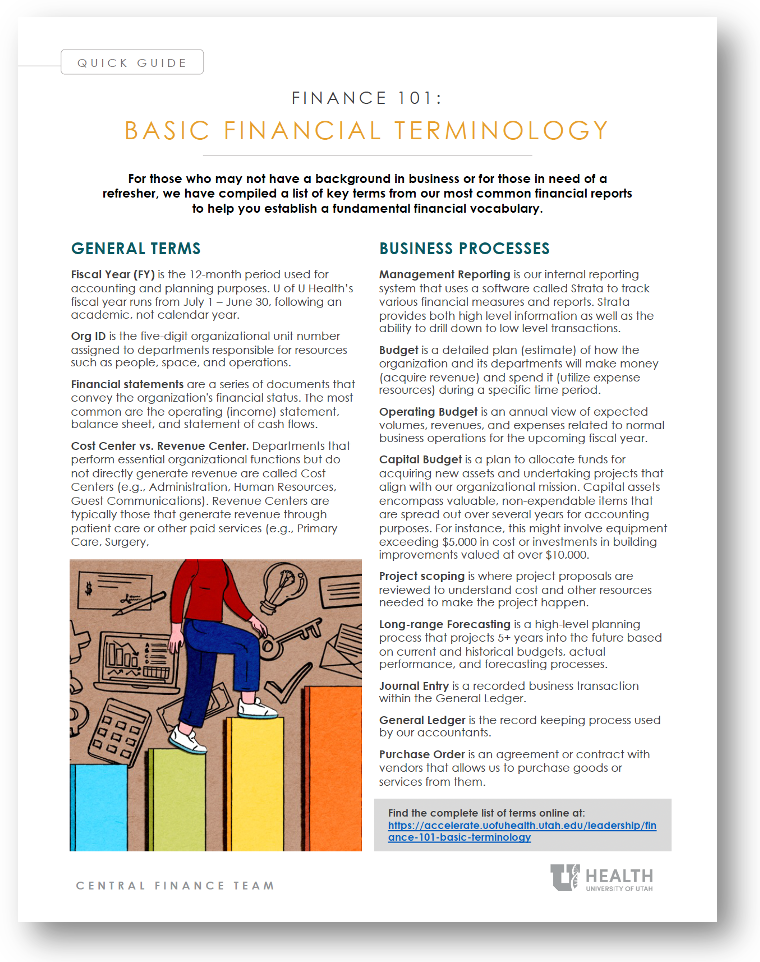nderstanding our organization's financial status is crucial for leaders at all levels, regardless of their background, but it can be intimidating for many of us who lack a finance-related education. Whether or not you have formal financial responsibilities such as budgeting and management reporting, we all play a part in contributing to our organization's financial well-being.
For those who may not have a background in business or for those in need of a refresher, we have compiled a list of key terms from our most commonly used financial reports to help you establish a fundamental financial vocabulary.
U of U Health’s Finance Terminology 101
- Fiscal Year (FY) is the 12-month period used for accounting and planning purposes. U of U Health’s fiscal year runs from July 1 – June 30, following an academic, not calendar year.
- Org ID is the five-digit organizational unit number assigned to departments responsible for resources such as people, space, and operations.
- Financial statements are a series of documents that convey the organization's financial status. The most common are the operating (income) statement, balance sheet, and statement of cash flows.
- Cost Center vs. Revenue Center. Departments that perform essential organizational functions but do not directly generate revenue are called Cost Centers (e.g., Administration, Human Resources, Guest Communications). Revenue Centers are typically those that generate revenue through patient care or other paid services (e.g., Primary Care, Surgery, Laboratory).
- Management Reporting is our internal reporting system that uses a software called Strata to track various financial measures and reports. Strata provides both high level information as well as the ability to drill down to low level transactions.
- Budget is a detailed plan (estimate) of how the organization and its departments will make money (acquire revenue) and spend it (utilize expense resources) during a specific time period.
- Operating Budget is an annual view of expected volumes, revenues, and expenses related to normal business operations for the upcoming fiscal year.
- Capital Budget is a plan to allocate funds for acquiring new assets and undertaking projects that align with our organizational mission. Capital assets encompass valuable, non-expendable items that are spread out over several years for accounting purposes. For instance, this might involve equipment exceeding $5,000 in cost or investments in building improvements valued at over $10,000.
- Project scoping is where project proposals are reviewed to understand cost and other resources needed to make the project happen.
- Long-range Forecasting is a high-level planning process that projects 5+ years into the future based on current and historical budgets, actual performance, and forecasting processes.
- Journal Entry is a recorded business transaction within the General Ledger.
- General Ledger is the record keeping process used by our accountants.
- Purchase Order is an agreement or contract with vendors that allows us to purchase goods or services from them.
- Key Performance Indicators (KPIs) are a set of quantifiable measures used to gauge our overall short and long-term performance.
- Statistics are measures used to count productivity (E.g., visits, surgeries, sales transactions, etc.) You may also hear this called census, volumes, and relative value units (RVUs).
- Target refers to a performance measure that helps determine if an area or measure is on track with its goal or benchmark. This is a newer term that we’ve been using.
- Actual(s) refers to the real or recorded amounts of money (revenue), costs (expenses), and data (statistics) related to what was proposed on your budgets. The difference is called variance.
- Variance is the measure of actual performance compared to the budget, target, or benchmark.
- Flex Account is an account that fluctuates (goes up and down) based on your volumes.
- Flex Budget is a change to a department's planned money based on how much they actually do (actual volumes). For example, if you budgeted to see 100 patients but you actually saw 110, any flex accounts set-up would represent 110% of your base budget.
- Per Unit of Service is a way to compare something to how much of it you have. For instance, if we talk about the supply expense per unit of service at a clinic, it means we're looking at how much money, on average, is used for supplies during each visit.
- Bottom line is the final financial total you get after subtracting (deducting) all expenses from your revenue. Also known as margin, operating gain/loss, or net income.
- Revenue is the inflow of money to departments and the organization related to services performed.
- Gross revenue is the total revenue generated within a period of time before deducting any expenses.
- Net patient revenue is the total revenue generated from services provided (patient care, sales transactions, etc.) before deducting any expenses (e.g., contractuals, bad debt, or charity care).
- Expenses are costs incurred to operate our business. Some examples include salaries, supplies, and building leases.
- Deductions are any item or expenditure that is subtracted from revenue, like contractuals, bad debt, or charity care.
- Controllable expenses are the costs that a manager or supervisor can usually influence and change as necessary. Examples of these expenses include labor and supply usage, as well as the choice of products to be used.
- Fixed vs variable expenses. Fixed and variable expenses are different in how they behave. Variable expenses can be changed quickly based on what you need, while fixed expenses stay the same regardless of outside factors. For instance, rent is considered a fixed expense because it doesn't change regularly, but supplies are variable expenses because they can change depending on usage or the products you choose.
- Purchased services are services provided by an outside company (third-party vendor) for which we pay.
- Inflationary increase means the cost of goods and services is going up. A "price increase" is when we raise the amount we charge for our services.
- Spread refers to how revenue, expenses, or volume is distributed over the course of a year. For instance, if you have $120 and want to spread it evenly across a year, each month would receive $10. Another example involves distributing the $120 based on volume, where the total is divided to match the fluctuations in volume.
- Full-Time Employee (FTE), or full-time equivalent, is a way to measure how much work a person does compared to a standard full-time workweek, which is typically 40 hours. For example, if someone works 32 hours a week, their FTE would be 0.75, indicating they're three-quarters of a full-time worker. So, if you have a team of 10 staff members, your FTE may be less than 10 because some staff members work fewer than 40 hours each week. It's important to note that FTE is different from headcount, which simply counts the number of individuals on your team.
- Productive vs Non-Productive Labor Productive labor refers to the hours spent doing actual work or training. Non-productive labor, on the other hand, includes any time when an employee is away from work for reasons such as taking paid time off (PTO), holidays, or Family and Medical Leave Act (FMLA) leave.
- Wage Rate is the amount of money a person is paid for their work. For salaried employees (exempt), it’s typically expressed on an annual basis. For hourly workers (non-exempt), it is expressed as an amount per hour.
UUHC Helpful Resources
-
Hospital Finance (Pulse) – direct links to policies, budgeting, and reports can be found here, as well as finance team contact information.
-
Budgeting (Pulse) – access the budgeting system and training for both operating budget and management reporting.
-
System Definitions (Pulse) – a comprehensive glossary of terms for policies, programs, and process at U of U Health.
Casey Moore
Clint Reid
Understanding financial reports is crucial for leaders making informed decisions for their teams and departments. Finance leaders Clint Reid, Casey Moore, and Robert Dickson walk us through some of the most common reports that leaders can utilize in operations and strategy.
Navigating budgets and finance can be a daily responsibility for managers, which is not always an easy task. Finance experts Casey Moore and Robert Dickson share the importance of and best practices for Management Reporting and how it can help you become a better leader.
What is “Value Management” and why should you care? It's how University of Utah Health systematically improves the quality of care delivered to patients—and its never been more important as we redesign care during a pandemic. Chief Quality Officer Sandi Gulbransen shares the seven tenets of Value Management that guide our work.

